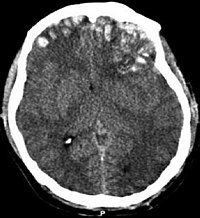
Photo from wikipedia
Background Diffuse axonal injury (DAI) is typically associated with significant mechanisms of injury and the effects of acceleration-deceleration forces on brain tissues. The prognosis of DAI remains a matter of… Click to show full abstract
Background Diffuse axonal injury (DAI) is typically associated with significant mechanisms of injury and the effects of acceleration-deceleration forces on brain tissues. The prognosis of DAI remains a matter of active investigation, but little is known about outcome differences between adult and pediatric populations with DAI. Methods We performed a retrospective cohort study involving blunt trauma patients with DAI between the years 1997 and 2018 from the Israeli National Trauma Registry. The patients were divided to pediatric (age <15 years) and adult (age >15 years) groups, with subsequent comparison of demographics and outcomes. Results Diffuse axonal injury was identified in 1983 patients, including 469 pediatric victims (23.6%) and 1514 adults (76.4%). Adults had higher Injury Severity Score (20.5% vs 13.2%, P = 0.0004), increased mortality (17.7% vs 13.4%, P < 0.0001), longer hospitalizations (58.4% vs 44.4%, P < 0.001), and higher rehabilitation need rates (56.4% vs 41.8%, P < 0.0001). Associated extracranial injuries were also more common in adults, particularly to the chest. Conclusions Pediatric patients with DAI have improved outcomes and fewer associated injuries than adult counterparts.
Journal Title: Pediatric Emergency Care
Year Published: 2022
Link to full text (if available)
Share on Social Media: Sign Up to like & get
recommendations!